Dogs
Top 10 Army Dog Training Jobs
Explore the exciting world of Army Dog Training Jobs with roles like Explosive Detection Dog Trainer, Canine Behavior Specialist, and more!

As we explore the various duties of army dog training roles, we discover the specialized skills and expertise required in each area. Whether it’s training dogs to sniff out explosives or drugs, or teaching them advanced tactics for tactical operations, each role is essential in improving the abilities of military working dogs. Additionally, positions like Canine Health and Wellness Specialist underscore the importance of maintaining the physical and mental well-being of these canine soldiers to ensure top performance in the field. The wide range of opportunities in army dog training emphasizes the importance of this profession in protecting military personnel and enhancing national security.
Key Takeaways
- Explosive Detection Dog Training: Train dogs to detect explosives accurately and reliably using positive reinforcement techniques.
- Behavior and Performance Enhancement: Analyze and modify dog behavior to enhance military working dogs' performance.
- Tactical Operations Training: Train dogs for specific tactical operations to ensure prompt threat detection.
- Search and Rescue Techniques: Utilize advanced tracking techniques and positive reinforcement training for search and rescue missions.
- Narcotics Detection Training: Collaborate closely with canine partners to train and deploy dogs efficiently in combating drug trafficking.
Explosive Detection Dog Trainer
Explosive Detection Dog Trainers meticulously train canines to accurately detect explosives, guaranteeing utmost safety in diverse operational settings. As Military Working Dog Handlers, we comprehend the critical nature of our role in training Military Working Dogs to search for both narcotic drugs and explosives. Our training methods are finely tuned to enhance the dogs' abilities in detecting these threats with precision and speed. By utilizing positive reinforcement techniques and scent detection training, we instill in our canine partners the skills needed to identify explosive materials effectively.
In collaboration with military personnel, we simulate real-world scenarios to prepare our dogs for missions where their keen sense of smell can make a life-saving difference. Our focus lies in achieving the highest level of accuracy, speed, and reliability in detecting explosive substances. Through our dedication to rigorous training standards, we make certain that our dogs are well-prepared to detect and alert to potential dangers, thereby maintaining the safety and security of our operational environments.
Canine Behavior Specialist

Drawing on our extensive knowledge of canine behavior, we specialize in analyzing and modifying dog behavior to optimize training outcomes for military working dogs. Canine Behavior Specialists play an essential role in enhancing the performance of military working dogs through targeted behavior modification techniques. By applying scientific principles and utilizing effective training methodologies, we address specific issues that may impede a dog's ability to excel in roles such as detection, patrol, and combat support. Our job involves closely collaborating with handlers to make sure that the dogs are adequately prepared for their duties. The table below highlights key aspects of the Canine Behavior Specialist role in training military working dogs:
| Key Aspects | Description | Importance |
|---|---|---|
| Analyzing Behavior | Utilizing behavioral analysis to understand and address issues in military working dogs | Enhances training outcomes |
| Modifying Behavior | Implementing behavior modification techniques to improve the performance of the dogs | Optimizes working capabilities |
| Working with Handlers | Collaborating with handlers to tailor training programs and ensure effective communication | Enhances handler-dog teamwork |
Tactical K9 Unit Trainer
Utilizing our expertise in training military working dogs for specific tactical operations, Tactical K9 Unit Trainers focus on enhancing the dogs' abilities to detect explosives, narcotics, and threats in high-risk environments. Our role is pivotal in shaping these K9s into proficient assets capable of safeguarding personnel and securing areas effectively. Here are key aspects of our training approach:
- Implementing specialized techniques to refine the dogs' skills in detecting explosives and narcotic drugs.
- Conducting rigorous search and find exercises to simulate real-life scenarios and enhance the dogs' mission readiness.
- Training the dogs to respond swiftly to threats, ensuring prompt and accurate threat detection.
- Collaborating closely with handlers to optimize communication and coordination during operations.
- Continuously refining training methods to adapt to evolving threats and maintain peak performance in critical missions.
Through meticulous training and dedication, Tactical K9 Unit Trainers play an essential role in preparing these K9 teams for the challenges they may face, ultimately contributing to the success of high-stakes missions.
Search and Rescue Dog Handler
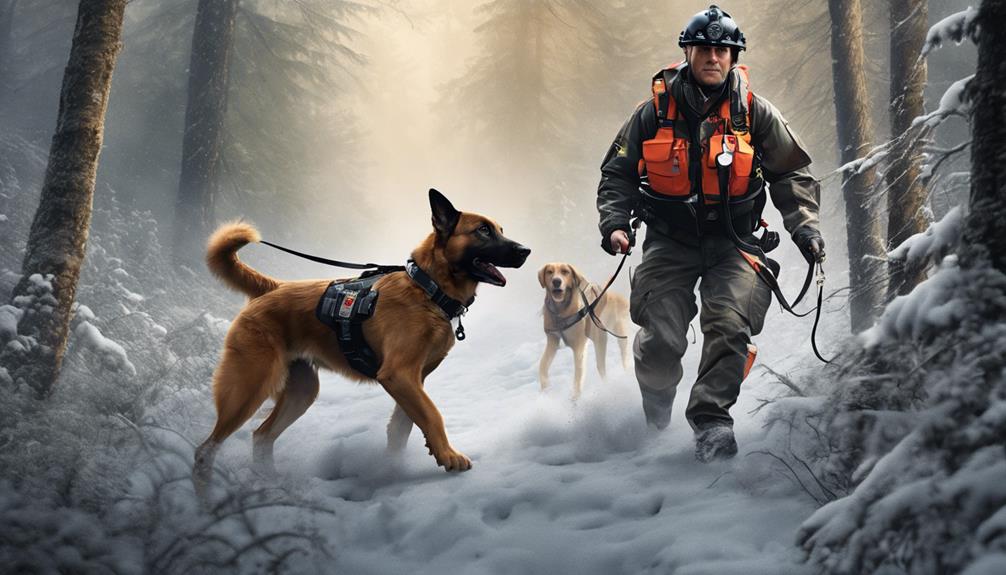
When training search and rescue dogs, we focus on utilizing advanced techniques to enhance their tracking and alert capabilities.
Our rigorous physical fitness requirements guarantee that handlers can keep up with the demanding tasks involved in search and rescue operations.
Training Techniques Utilized
Search and rescue dog handlers employ positive reinforcement training techniques to equip their canine partners with the skills needed to locate missing individuals in diverse environments.
- Scent Detection Training: Dogs are trained to identify and locate specific scents related to missing persons.
- Agility Exercises: Enhancing the dog's physical abilities to navigate various terrains quickly and efficiently.
- Obedience Training: Teaching dogs to respond promptly to commands during search and rescue operations.
- Positive Reinforcement: Rewarding desired behaviors with treats, toys, or playtime to motivate the dog.
- Handler-Dog Relationship: Building a strong bond between handler and dog to effectively communicate and work as a cohesive team during missions.
Physical Fitness Requirements
Ensuring peak physical condition is a fundamental requirement for Search and Rescue Dog Handlers, essential to their operational readiness and effectiveness in fulfilling their duties.
Meeting the Army Combat Fitness Test (ACFT) standards multiple times a year is imperative. Handlers must adhere to height and weight standards to optimize their performance in search and rescue missions.
Maintaining high physical fitness levels is crucial for Handlers to effectively support operations. The ACFT assesses the physical abilities of Handlers, ensuring they can handle the job's demands.
Physical fitness is a cornerstone of success for Search and Rescue Dog Handlers, directly impacting their ability to excel in their roles and contribute significantly to mission outcomes.
Military Working Dog Instructor
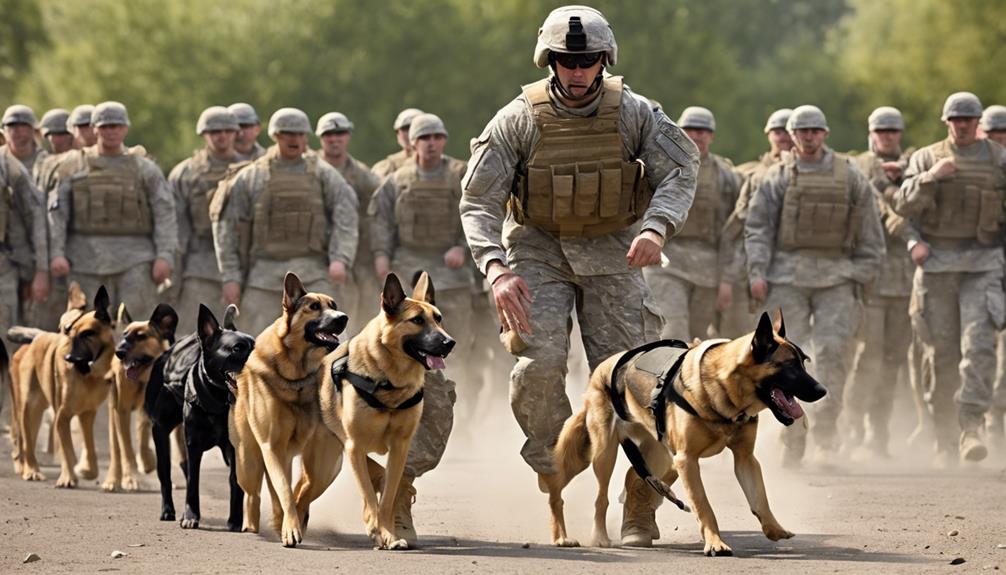
Military Working Dog Instructors meticulously train K-9 units to excel in specialized tasks important for mission success and law enforcement operations. These skilled professionals play a critical role in preparing dogs for the challenging responsibilities they'll face in the field.
Here are five key aspects of the Military Working Dog Instructor role:
- Specialized Training: Instructors focus on teaching K-9 units how to detect narcotics, explosives, and other threats, ensuring they're well-prepared for their duties.
- Mission Support: By honing the detection skills of the dogs, Instructors directly contribute to the success of missions and law enforcement operations.
- Obedience Emphasis: Training programs emphasize obedience training to make certain that the dogs can follow commands reliably in high-pressure situations.
- Detection Skills: Instructors work on developing the dogs' abilities to detect specific scents accurately and efficiently.
- Expertise Required: This role demands a deep understanding of canine behavior and advanced training techniques to bring out the best in the K-9 units.
Obedience Training Supervisor
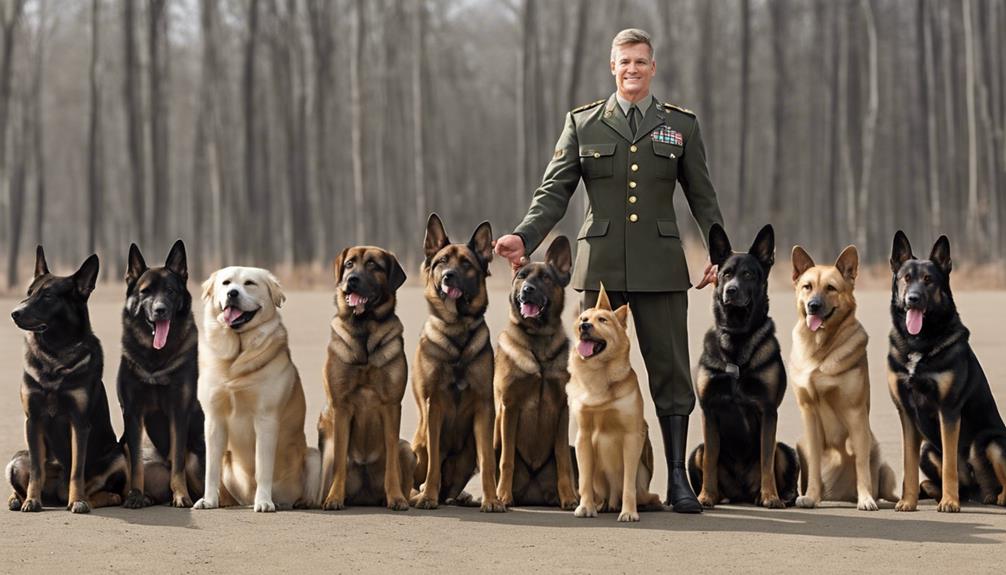
Supervisors overseeing obedience training for military working dogs play an essential role in shaping the dogs' responsiveness to commands essential for mission readiness and success. Obedience Training Supervisors are responsible for making sure that the dogs respond promptly and accurately to obedience commands, laying the foundation for successful mission outcomes.
By utilizing positive reinforcement techniques, these supervisors reinforce desired behaviors in the dogs, creating a strong bond between handler and canine. Their expertise is vital in preparing the dogs for a variety of tasks such as patrol, detection, and apprehension, contributing greatly to the overall effectiveness of the canine unit.
Working closely with handlers, Obedience Training Supervisors maintain high standards of training and performance, constantly aiming for excellence in the dogs' obedience and responsiveness. Their attention to detail and dedication to training ensure that military working dogs are well-equipped to carry out their duties with precision and reliability.
Tracking and Patrol Dog Trainer

As Tracking and Patrol Dog Trainers, we employ specialized techniques to guarantee dogs are mission-ready for tactical operations.
We focus on training dogs to track scents and footsteps using positive reinforcement.
Our expertise lies in teaching dogs to follow trails, maintain focus, and alert handlers to potential threats.
Specialized Training Techniques
Employing advanced scent detection methods, we hone the skills of tracking and patrol dogs to excel in locating targets or suspects efficiently. Specialized training techniques for tracking and patrol dogs are essential in law enforcement and military operations.
Here are key aspects of our training approach:
- Teaching dogs to follow scents effectively
- Training dogs to track movements accurately
- Maintaining focus during search operations
- Using positive reinforcement to encourage desired behaviors
- Emphasizing obedience, agility, and responsiveness
Through these methods, we prepare our canine companions to be valuable assets in challenging environments, ensuring they're ready to fulfill their roles with precision and dedication.
Tactical Mission Readiness
In preparing tracking and patrol dogs for tactical missions, our focus sharpens on optimizing their detection abilities and readiness for operational tasks. Our training methods are meticulously designed to enhance the dogs' tracking skills and guarantee they are well-prepared for any threats they may encounter during tactical operations. As tracking and patrol dog trainers, we play a vital role in teaching these dogs how to locate targets, individuals, or objects efficiently in the field. Our mission is to secure the effectiveness and efficiency of military working dogs in carrying out their tracking and patrol duties.
| Training Methods | Mission Readiness Goals |
|---|---|
| Scent Detection Training | Enhancing detection abilities |
| Aggression Control Techniques | Ensuring controlled responses |
| Obedience Training | Maintaining discipline in operations |
| Scenario-based Exercises | Preparing for real-life situations |
| Continual Assessment | Monitoring progress and improvement |
Narcotics Detection Canine Handler

Trained to detect illegal drugs such as cocaine, heroin, and methamphetamine, Narcotics Detection Canine Handlers play an essential role in law enforcement operations by assisting in locating and identifying narcotics during searches. These professionals possess specialized expertise in training and working with detection dogs to guarantee effective detection of illicit substances.
- Training Programs: Narcotics Detection Canine Handlers undergo rigorous training programs that focus on teaching dogs to recognize specific scents associated with various drugs.
- Collaboration with Canine Partners: Handlers work closely with their canine partners to maintain a strong working relationship that enhances the accuracy of drug detection.
- Regular Maintenance: Handlers must consistently train and certify their canine partners to assure the ongoing effectiveness of their detection skills.
- Environment Adaptability: Handlers are skilled at deploying their canine partners in various environments to detect narcotics efficiently.
- Critical Role: These professionals are vital in aiding law enforcement agencies in combating drug trafficking and keeping communities safe.
Canine Health and Wellness Specialist
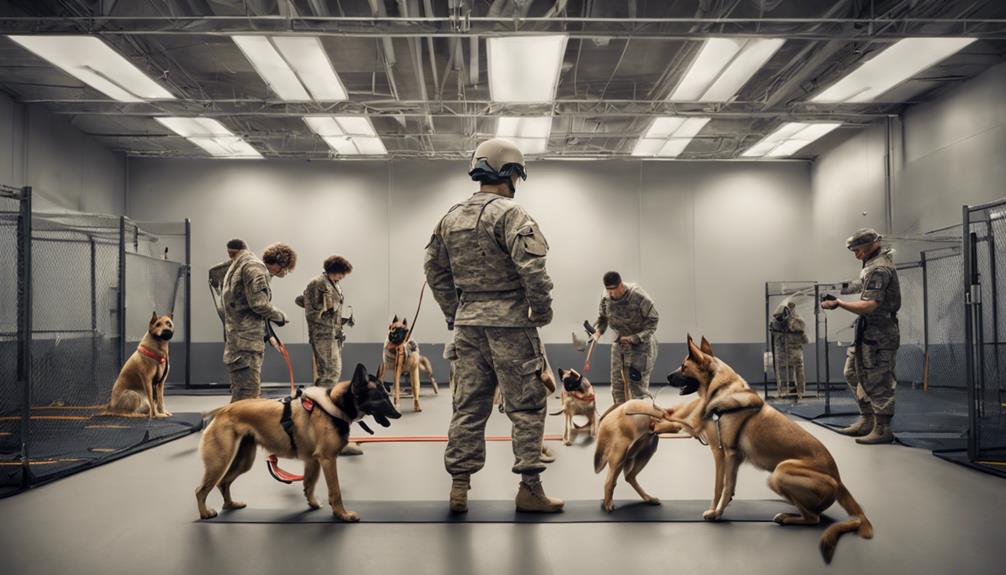
Working alongside Narcotics Detection Canine Handlers, Canine Health and Wellness Specialists focus on maintaining the physical and mental well-being of military working dogs. These specialists ensure that K-9 units receive proper nutrition, exercise, and medical care to perform at their best in their duties. By providing preventive care and working closely with veterinarians, these experts play a vital role in sustaining the overall health and fitness of service dogs. Their attention to detail and expertise contribute greatly to the longevity and effectiveness of military working dogs during various missions.
| Canine Health and Wellness Specialist | Military Working Dogs |
|---|---|
| Focus on physical and mental well-being | Ensure peak performance |
| Provide nutrition, exercise, and medical care | Collaborate with veterinarians |
| Offer preventive care for service dogs | Contribute to endurance and effectiveness |
Canine Health and Wellness Specialists are instrumental in upholding the well-being of these loyal and hardworking animals, ensuring they are prepared for any task at hand.
Advanced Training Techniques Expert
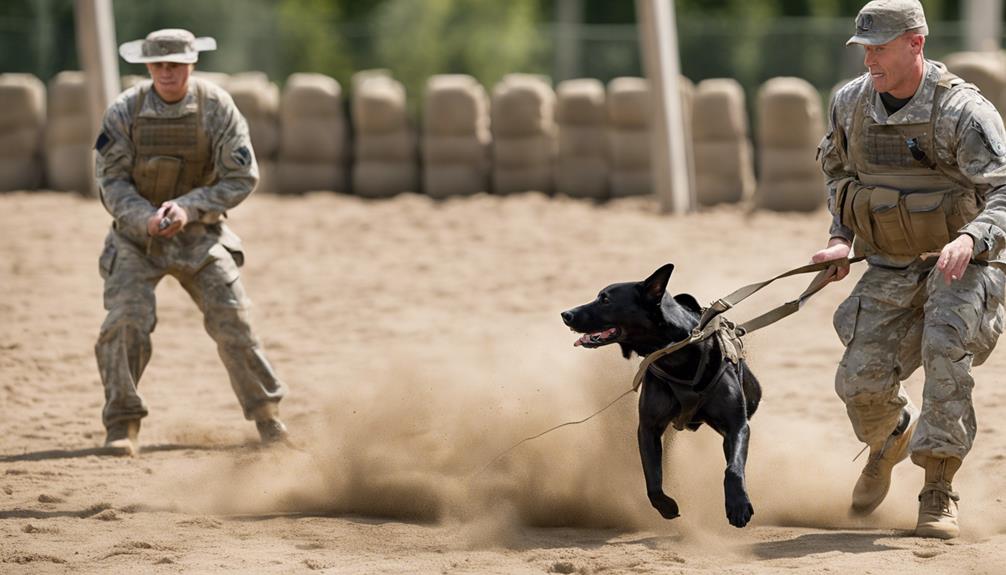
With a focus on refining specialized skills for military working dogs, our expertise as Advanced Training Techniques Experts lies in designing and implementing cutting-edge programs to enhance K-9 unit capabilities. We're dedicated to honing the detection skills and specialized abilities of these elite canines, ensuring they excel in high-stress environments. Our role is pivotal in preparing K-9 teams for complex missions, where their performance can make a significant difference in the field.
Here are five key aspects of our work:
- Developing and executing advanced training programs tailored to enhance military working dogs' skills.
- Utilizing innovative methodologies to elevate detection capabilities and tracking efficiency.
- Enhancing the apprehension skills of K-9 units through specialized training techniques.
- Preparing dogs to operate effectively in high-stress environments and navigate challenging scenarios.
- Contributing to the overall effectiveness and operational readiness of military working dog teams.
Frequently Asked Questions
What Army Jobs Work With Dogs?
We train and handle Military Working Dogs in the Army. Our K-9 units support missions, detect explosives, and serve as non-lethal security measures. We undergo rigorous training to guarantee readiness and effectiveness in our roles.
Who Trains Dogs for the Military?
We, as military dog trainers, are responsible for preparing canines for service. Our methods involve specialized courses, clear signals training, and positive reinforcement techniques. The bond between handlers and dogs is important for achieving best performance in military tasks.
How Much Do Dog Handlers Make in the Army?
To excel as an Army dog handler, one must embody dedication and discipline. Salaries range from $37,000 to $149,465 annually, inclusive of benefits. The compensation package exceeds federal minimum wage and offers valuable bonuses and educational perks.
What Rank Are Dog Handlers in the Army?
In the Army, Dog Handlers hold various ranks, including enlisted Soldiers and commissioned Officers. The rank of a Dog Handler impacts their responsibilities and leadership opportunities. Different ranks come with varying levels of authority and command responsibilities.
Are Army Dog Training Jobs Transferable to Civilian Dog Training Jobs in Colorado Springs?
Yes, Army dog training jobs in Colorado Springs are transferable to civilian dog training jobs. The skills and experience gained in the military are highly valued in the civilian sector. Many veterans have successfully transitioned to careers in dog training in Colorado Springs, leveraging their expertise in working with canines.
Are the Skills from Army Dog Training Jobs Transferable to PetSmart Dog Training Jobs?
The skills acquired from army dog training jobs are highly transferable to exciting PetSmart training jobs. Both require discipline, obedience training, and the ability to work with dogs in diverse settings. Handlers already possess the necessary expertise to excel in PetSmart dog training jobs.
Conclusion
As we wrap up our exploration of the top 10 army dog training jobs, it's clear that the bond between human and canine is a powerful force in the military.
Just like a well-trained dog confidently leading their handler through a dark and dangerous path, these specialized trainers guide their furry companions to success.
They're the unsung heroes behind the scenes, ensuring that our military can rely on their four-legged partners to protect and serve with unwavering loyalty.
Dana is our Lead Content Writer, bringing a wealth of knowledge and expertise to our team. With a background deeply rooted in animal studies and a profound love for all creatures, Dana is dedicated to crafting engaging and informative content that resonates with our audience. With Dana at the helm, you can trust that our content is accurate and engaging, catering to the diverse interests of animal enthusiasts everywhere.
Dogs
Dogs Are Better Than Cats: 7 Reasons

We are firm believers that dogs surpass cats for seven crucial reasons. Dogs, who have their origins in Central Asia 15,000 years ago, provide loyalty and companionship. They excel at tasks such as herding and guarding. Dogs offer health benefits, including disease detection and boosting immunity. They encourage active lifestyles and cognitive stimulation. Dogs form strong social bonds, which help to build communities and enhance social interactions. Their responsiveness to training commands strengthens the bond between humans and dogs. Dogs are also excellent at cleaning up after themselves, preferring to do their business outside. For more compelling reasons why dogs are superior, delve deeper into the topic.
Key Takeaways
- Dogs offer superior disease detection with their keen sense of smell.
- Dogs reduce allergies and asthma risks in children through immune system benefits.
- Dogs promote physical activity, social interactions, and community engagement.
- Dogs are trainable, responsive, and form strong social bonds with humans.
- Dogs contribute to indoor cleanliness by going potty outdoors and shedding less fur.
Historical and Cultural Significance
Dogs have long held a prominent place in history and culture, embodying qualities of loyalty and companionship across various civilizations. Unlike cats, who were domesticated in Egypt around 4,000 years ago, dogs have been by our side for approximately 15,000 years, originating in Central Asia. Throughout history, dogs have served a multitude of roles, from herding livestock to guarding homes. In contrast, cats were revered in ancient Egypt, with the goddess Bastet symbolizing their cultural significance.
Dogs haven't only been our companions but have also played integral roles in myths and folklore, representing loyalty, protection, and friendship in diverse cultures worldwide. The recognition of 189 dog breeds by the American Kennel Club showcases the extensive historical and cultural impact dogs have had on human societies. From hunting partners to service animals, dogs have woven themselves into the fabric of our history and continue to be cherished for their unwavering loyalty and companionship.
Health Benefits and Abilities

Highlighting the remarkable health benefits and abilities that dogs offer, it's fascinating to explore how these furry companions contribute to our overall well-being and daily lives. Dogs have a superior sense of smell and can be trained to detect diseases like cancer, showcasing their incredible ability to aid in early detection. Exposure to dog dust has been linked to preventing allergies and asthma in children, highlighting the immune-boosting potential of having a dog around. Additionally, dogs encourage physical activity and a healthy lifestyle by promoting regular exercise, keeping both their owners and themselves fit and active. Their cognitive abilities are also impressive; dogs can be trained to take selfies and respond to commands on iPads, demonstrating their intelligence and adaptability. Moreover, having a dog around can help build immunity in infants by altering intestinal bacteria, providing a natural boost to the immune system. These health benefits and abilities make dogs invaluable companions for a healthier and happier life.
| Health Benefits and Abilities | |
|---|---|
| Superior sense of smell for disease detection | Prevention of allergies and asthma |
| Encouragement of physical activity | Impressive cognitive abilities |
| Boosting immunity, especially in infants |
Social Interactions and Connections

Dogs are known for their ability to form strong social bonds with both humans and other dogs, enhancing our connections with others.
Their friendly and approachable nature often leads to interactions with fellow dog owners during walks and outings.
These interactions can foster a sense of community and belonging among dog owners, creating opportunities for shared experiences and friendships.
Canine Social Bonds
Engaging with canine companions fosters meaningful social connections and interactions, enriching our lives in various ways. Dogs not only increase social interactions but also promote community engagement through activities like dog meetups and dedicated social media pages. Laughter and shared playful interactions with dogs contribute to a higher quality of life. Additionally, owning a dog encourages physical activity as dog owners tend to walk more, leading to improved fitness levels and overall well-being. The bond between humans and dogs goes beyond companionship, extending to enhancing our social experiences and well-being. Below is a table summarizing the positive impact of canine social bonds:
| Aspects | Benefits |
|---|---|
| Social Interactions | Increased interactions |
| Community Engagement | Promotes community involvement |
| Physical Activity | Encourages regular exercise |
Feline Independence Nature
Exploring the feline independence nature reveals a distinctive approach to social interactions and connections compared to dogs. Cats tend to exhibit more independent behavior, leading to fewer social interactions. Their selective nature when socializing results from their historical role as hunters, impacting how they respond to social stimuli.
Unlike dogs, whose sociable behavior encourages owners to engage in more social activities, cats prefer solitude and choose when to interact. Understanding the feline independence nature helps us appreciate their unique way of forming connections, which may be more subtle but equally meaningful.
While dogs promote increased social interactions, cats offer a different perspective on companionship, appealing to those who value independence and selective social bonds.
Training and Responsiveness

When it comes to training and responsiveness, the key factor that sets dogs apart from cats is their innate ability to learn and adapt to various tasks. Dogs can be trained to perform a wide range of tasks, showcasing their high level of responsiveness to commands and cues. This trainability not only demonstrates their intelligence but also enhances the bond between dogs and humans through effective communication.
On the other hand, cats, historically used for hunting, may exhibit less responsiveness compared to dogs. While cats may recognize their names, they often display selective hearing by choosing not to respond. This behavior contrasts with dogs' enthusiasm to learn and their willingness to engage in training exercises.
Allergies and Asthma Prevention

Exposure to dog dust has been proven to lower the likelihood of developing allergies and asthma in kids. Having a dog around can change the gut bacteria, which in turn boosts the immune system.
Dogs can help strengthen immunity in young ones, potentially decreasing the risk of allergies and asthma.
Pet Dander Control
Pets play an important role in maintaining a healthy environment by controlling pet dander, thereby helping prevent allergies and asthma. Exposure to dog dust can reduce the risk of allergies and asthma in children. Dogs alter intestinal bacteria, leading to improved immune responses and allergy prevention. Having a dog around can help build immunity in infants and children. Dogs provide unique health benefits that aid in preventing allergies and asthma. Cats do not offer the same protective effects against allergies and asthma as dogs do.
| Key Points |
|---|
| Exposure to dog dust can reduce allergies and asthma risk in kids. |
| Dogs alter intestinal bacteria, improving immune responses. |
| Having a dog can boost immunity in infants and children. |
| Dogs offer unique health benefits for allergy and asthma prevention. |
| Cats lack the protective effects against allergies and asthma that dogs provide. |
Respiratory Health Benefits
Dogs' unique respiratory health benefits, particularly in preventing allergies and asthma, make them invaluable companions for individuals seeking improved well-being. Exposure to dog dust can reduce the risk of allergies and asthma in children, thanks to the alterations in intestinal bacteria that lead to a better immune response.
Studies also indicate that having a dog around can help build immunity in infants, demonstrating the positive impact dogs make on respiratory health. Compared to cats, dogs provide distinct advantages in preventing respiratory issues, contributing to a healthier home environment overall. For people concerned about allergies and asthma, having a dog may offer significant benefits in maintaining better respiratory health.
Cleanliness and Housekeeping

Maintaining a clean and tidy home is easier with dogs, as they can be trained to do their business outside, reducing the need for indoor cleanup. Dogs help you make sure your house stays fresh and clean by learning to go potty outdoors. Dog houses are typically cleaner and neater compared to homes with cats, as dogs keep their bathroom activities outside.
Regular de-shedding of dogs can also help you maintain cleanliness in your house, minimizing fur around the place. Cats and dogs have different bathroom habits, with dogs needing to be taken outside for their business. Dogs can even be trained to let you know when they need to go outside, making the cleanup process more manageable.
Cats, on the other hand, require litter boxes, which can sometimes create odors and messes in the house. Additionally, cats may vomit or cough up hairballs, leading to extra cleaning tasks around the house.
Celebration and Festivities

During festive occasions, dogs bring an extra element of joy and excitement with their enthusiastic participation. Holiday celebrations become even more special when our furry friends join in the fun. Dressing up dogs in costumes for Halloween is a popular activity that many pet owners enjoy. Seeing our pets prance around in themed outfits adds to the festive spirit and creates lasting memories.
Including dogs in holiday activities like parades or family gatherings can make these events even more enjoyable. Pets, especially dogs, have a way of spreading happiness and bringing people together during festive occasions. The experience of dressing up and going out with a dog during holidays can be heartwarming and delightful.
Frequently Asked Questions
What Are 5 Reasons Dogs Are Better Than Cats?
When comparing dogs and cats, five reasons why dogs are superior include their trainability, security instincts, encouragement for physical activity, constant companionship, and unwavering loyalty.
Dogs excel in learning commands, alerting owners of potential threats, motivating owners to exercise, showing excitement when reunited, and staying devoted during tough times.
These qualities make dogs exceptional pets that enhance our lives in numerous ways.
Why Do Dogs Obey Better Than Cats?
Dogs obey better than cats due to their history of working with humans and training. Dogs' ability to follow commands stems from their trainable nature and desire to please their owners. Through training, dogs learn behaviors and cues, enhancing their responsiveness to instructions.
Cats, historically used for hunting, may exhibit less obedience.
The bond between dogs and humans is strengthened by their obedience, making them excellent companions who can work and communicate effectively with us.
What Is Better Dogs or Cats?
When considering whether dogs or cats are better, it ultimately depends on individual preferences and lifestyle. Dogs offer loyalty, companionship, and are great for physical activities like running.
On the other hand, cats are independent and require less maintenance. Both have their unique qualities, so the choice between dogs and cats boils down to personal needs and what one values in a pet.
Choose based on what aligns best with your lifestyle and preferences.
Are Dogs More Loyal Than Cats?
Yes, dogs are generally more loyal than cats. This loyalty is evident in their protective instincts and unwavering dedication to their owners. Dogs prioritize their owner's safety and well-being, forming strong bonds based on trust and companionship.
While cats may exhibit independent behavior, dogs consistently display loyalty and devotion, making them excellent companions for those seeking faithful and devoted animal companions.
Can Antibiotics Affect a Dog’s Behavior and Health, Making Them a Better Pet Than Cats?
Some antibiotics and increased urination in dogs can affect their behavior and health. While it’s important to consult a veterinarian first, antibiotics can improve a dog’s health, making them more active and lively pets than cats. Regular check-ups and proper medication can help ensure a happy and healthy pet.
What Are the Benefits of Feeding Raw Dog Food Compared to Traditional Dog Food?
When it comes to the benefits of raw dog food, many dog owners believe it offers a more natural and nutritious option for their pets. Raw dog food advocates claim it can improve digestion, promote healthier coats and skin, and increase energy levels in dogs compared to traditional dog food.
Conclusion
To sum up, dogs truly are man's best friend. Their loyalty, intelligence, and companionship make them the superior pet choice.
Just like a trusty sidekick in a superhero movie, dogs are always there to support and protect us.
So next time you're considering getting a pet, remember the numerous benefits that come with having a furry four-legged friend by your side.
Choose a dog, and you won't be disappointed!
Dana is our Lead Content Writer, bringing a wealth of knowledge and expertise to our team. With a background deeply rooted in animal studies and a profound love for all creatures, Dana is dedicated to crafting engaging and informative content that resonates with our audience. With Dana at the helm, you can trust that our content is accurate and engaging, catering to the diverse interests of animal enthusiasts everywhere.
Dogs
Top 3 Benefits of Instinct Raw Dog Food: Reviewed
Nourish your dog's primal instincts with Instinct Raw Dog Food, offering essential nutrients, digestive support, and premium quality ingredients that set it apart from the rest.

Instinct Raw Dog Food gives three key benefits: Firstly, by mimicking a wild diet, it connects with a dog’s primal instincts using unprocessed ingredients sourced globally, highlighting their carnivorous roots and essential nutrient intake. Secondly, its high-quality standards feature non-GMO, grain-free elements packed with probiotics and Omega-Fatty Acids, supporting digestive health and overall well-being. Lastly, the nutrient-rich formula contains elevated protein and fat levels from premium animal proteins like liver and kidney, perfect for dogs of any age and promoting a healthy lifestyle. Explore how Instinct Raw Dog Food elevates your pet’s nutrition game.
Key Takeaways
- Supports a dog's natural instincts with raw, unprocessed ingredients.
- Provides high-quality, globally sourced, and non-GMO ingredients.
- Ensures a nutrient-dense diet with 42% protein and 27% fat content.
- Includes essential nutrients like beef liver, kidney, and spleen.
- Promotes overall well-being and is suitable for dogs at any life stage.
Wild Diet Mimicry
Mimicking a wild diet, Instinct Raw Dog Food incorporates real, whole, and uncooked ingredients to satisfy a dog's natural carnivorous instincts for the best nutrition. This approach acknowledges the evolutionary history of dogs as hunters and meat-eaters, emphasizing the importance of raw, unprocessed elements in their diet. By mirroring the diet that canines would consume in the wild, Instinct Raw Dog Food guarantees that essential nutrients and proteins are provided, supporting the overall health and well-being of our furry companions.
Understanding a dog's carnivorous tendencies is important in selecting the right food for them. Instinct Raw Dog Food's commitment to real ingredients that are uncooked aligns with the dietary requirements that have been ingrained in dogs over generations. This wild diet mimicry isn't just a key aspect of promoting a healthy lifestyle for our pets; it's an essential part. With Instinct Raw Dog Food, we can nurture our dogs with the nutrition they instinctively crave, fostering their overall health and vitality.
Quality Natural Ingredients

Utilizing a variety of high-quality meats and nutrient-rich additions, Instinct Raw dog food guarantees superior quality through its selection of natural ingredients. The recipes are carefully crafted to include real, whole ingredients such as beef, chicken, and lamb, sourced globally from trusted suppliers.
Here's why Instinct Raw dog food stands out regarding ingredient quality:
- Non-GMO Ingredients: By utilizing non-genetically modified organisms, Instinct Raw ensures that your furry friend receives a natural and wholesome diet free from artificial interference.
- Probiotics and Omega-Fatty Acids: These beneficial additions support digestion and overall well-being, promoting a healthy gut and a shiny coat.
- Grain-Free and Free from Artificial Colors and Preservatives: Instinct Raw dog food prioritizes natural ingredients by excluding grains, artificial colors, and preservatives, providing dogs with a clean and nutritious meal that aligns with their natural dietary needs.
With a focus on quality, natural ingredients, Instinct Raw dog food delivers a balanced diet that caters to your pet's health and happiness.
Nutrient-Dense Support
Instinct Raw dog food guarantees a nutrient-dense formula with a protein content of 42% and fat content of 27%. This high-quality dog food is packed with essential nutrients derived from top-tier animal proteins like beef, chicken, and lamb. These ingredients, including beef liver, kidney, and spleen, contribute to the best nutrition necessary for your pet's well-being.
With above-average nutrition levels, Instinct Raw dog food guarantees a balanced diet suitable for dogs at any life stage, promoting a healthy lifestyle. The nutrient breakdown in this food not only supports your dog's overall health but also promotes a thriving existence.
Frequently Asked Questions
Is Instinct Raw Brand Dog Food Good for Dogs?
Yes, instinct raw brand dog food is outstanding for dogs. It offers high-quality ingredients, grain-free options, and a variety of formulas for all life stages. Backed by over 20 years of experience, it guarantees excellent nutrition.
What Is the Number One Healthiest Dog Food?
The number one healthiest dog food is Instinct Raw Frozen Dog Food. It boasts a 5-star rating, features high-quality ingredients, and offers above-average nutrition. Would you choose anything less for your beloved pet's well-being?
Is Instinct Dog Food Vet Approved?
Instinct dog food isn't vet-approved, but it's formulated by PhD nutritionists following AAFCO guidelines. Some vets recommend raw diets based on pet needs. Consult a vet before switching. They guide based on health conditions and dietary needs.
What Is the Most Nutritious Raw Food for Dogs?
For my furry friend, the most nutritious raw food is Instinct Raw Frozen Dog Food. Real ingredients like beef, liver, and veggies provide a balanced diet. It's grain-free, GMO-free, and full of probiotics for peak health.
What Are the Specific Benefits of Instinct Raw Dog Food Compared to Other Options?
Instinct Raw Dog Food offers unique health benefits of raw mix. This option provides dogs with a diet closer to what they would eat in the wild, leading to improved digestion, healthier skin and coat, and increased energy levels. Compared to other options, the raw mix in Instinct Raw Dog Food promotes overall well-being for your pet.
Is Almond Introduction Safe for Dogs Who Eat Instinct Raw Dog Food?
Before introducing almonds to dogs who eat Instinct raw dog food, it’s crucial to understand that not all nuts are safe for dogs. While almonds are not toxic, they can be a choking hazard and high in fat. It’s best to consult a vet for guidance on how to safely introduce dogs to almonds.
Conclusion
To sum up, feeding your dog Instinct raw dog food is like giving them a taste of the wild in every bite.
With quality natural ingredients and nutrient-dense support, your furry friend will thrive like never before.
Make the switch today and watch as their energy, coat, and overall health skyrocket to new levels.
Give them the best with Instinct raw dog food – they deserve it!
As our Editor-in-Chief, James plays a pivotal role in ensuring the quality and integrity of our content. With a keen eye for detail and a passion for storytelling, James oversees the editorial process here at A Place for Animals. With years of experience in content editing, James ensures that every piece of content meets our high standards of accuracy and clarity. Under James’ guidance, you can rest assured that the content you read is informative and impeccably crafted.
Dogs
7 Good Names for Your Black and White Dog
Kickstart your search for the perfect name for your black and white dog with these 7 charming options that will add personality and flair – keep reading to discover the ideal fit!

Consider Dottie, Perdita, Domino, Mickey, and others for your black and white dog’s name. These names infuse charm and character into your pet’s persona. Dottie, Domino, and Snoopy bring a fun vibe. Perdita and Mickey have ties to famous dog characters. Choose names that stand out and remain relevant as your dog grows. These options are just the beginning of a list that explores various themes and inspirations for naming your unique companion.
Key Takeaways
- Classic Black and White Dog Names: Timeless options like Dottie and Snoopy for enduring charm.
- Unique Monochrome Dog Names: Personalized names to match your dog's distinct appearance.
- Food-Inspired Names: Culinary titles such as Sushi or Macaron for a playful twist.
- Pop Culture Dog Name Ideas: Draw inspiration from movies or TV shows for a fun and distinctive name.
- Nature-Inspired Black and White Dog Names: Connect with the outdoors using names like River or Luna.
Classic Black and White Dog Names
When selecting a name for your black and white dog, consider classic options like Dottie, Perdita, Domino, Mickey, and Snoopy. These names have stood the test of time and are popular choices for dogs with white fur.
Perdita and Mickey, for example, have ties to famous black and white dog characters in movies, adding a touch of nostalgia to your pet's identity. Dottie, Domino, and Snoopy, on the other hand, bring a fun and playful vibe to the table, perfect for a lively companion.
Choosing a classic black and white dog name can infuse your pet's persona with charm and character. These names not only sound endearing but also have a timeless quality that will stay relevant as your dog grows.
Whether you opt for a more traditional name like Dottie or a whimsical choice like Snoopy, these classic options are sure to make your black and white dog stand out in any crowd.
Unique Monochrome Dog Names

Exploring unique monochrome dog names allows for personalization and creativity in naming your black and white companion. When choosing a unique monochrome name for your pet, consider names that reflect their distinct appearance and capture their individuality. These names can add a touch of charm and personality to your black and white dog, setting them apart from the more common dog names out there.
To find the perfect unique monochrome name, think about your dog's personality and characteristics. Are they playful and energetic, or calm and cuddly? Tailoring the name to match these traits can create a special bond between you and your furry friend. Whether you draw inspiration from food, pop culture, or nature, the key is to select a name that resonates with both you and your beloved pet. Embrace the opportunity to showcase your dog's uniqueness with a name that's as special as they are.
Food-Inspired Names for Bicolor Dogs
When considering food-inspired names for your black-and-white dog, you have a plethora of tasty options to choose from. Culinary canine titles like Sushi, Chocolate Chip, Almond Joy, Macaron, or Swirl can add a delightful touch to your pet's identity.
These delicious monikers not only reflect your love for food but also bring a whimsical charm to your furry friend's character.
Tasty Dog Name Ideas
We enjoy coming up with tasty food-inspired names for black-and-white dogs as a creative and fun way to personalize their identity. When considering names like Mocha, Oreo, or Pepper, you can capture your border collie or Boston Terrier's playful demeanor.
These culinary-inspired names, like Cinnamon or Cookie, can reflect your pet's love for food and add a touch of whimsy to their character. Choosing a food-inspired name for your pet can be a delightful way to showcase your creativity and celebrate your pup's unique traits.
Whether your dog enjoys treats like Sushi or is as sweet as Almond Joy, these names offer a fun and personalized option for naming your beloved black-and-white companion.
Culinary Canine Titles
Let's explore some delightful options for naming your black-and-white furry friend with our assortment of Culinary Canine Titles. When it comes to food-inspired names, pet parents love to draw inspiration from their favorite treats and dishes. These culinary canine titles create a playful connection between you and your dog, reflecting your love for food in a fun and unique way. Consider names like Sushi, Chocolate Chip, Almond Joy, Macaron, and Swirl to add a delicious twist to your dog's identity. These names not only showcase your pet's playful personality but also highlight their love for treats. Culinary Canine Titles offer a wide range of options to match your dog's individual characteristics and charm.
| Food-Inspired Names | Description |
|---|---|
| Sushi | For a sophisticated pup with a refined palate |
| Chocolate Chip | Perfect for a sweet and playful dog |
| Almond Joy | Ideal for a dog that brings joy into your life |
| Macaron | Suited for a stylish and elegant furry companion |
| Swirl | Great for a dog with a fun and whimsical nature |
Delicious Pet Monikers
Occasionally, incorporating food-inspired names can add a playful and delightful touch to your black-and-white dog's identity. For pet lovers who enjoy culinary creativity, names like Sushi, Chocolate Chip, Almond Joy, Macaron, and Swirl can be perfect choices.
These names not only reflect your passion for food but also highlight your dog's unique coloring in a fun way. Choosing a food-inspired name for your black-and-white furry companion can spark conversations and make a lasting impression.
Food-related names bring a charming and humorous element to your pet's persona, showcasing their playful nature and your love for all things delicious. So, consider these delicious pet monikers to give your bicolor dog a name that's as sweet as they are.
Pop Culture Dog Name Ideas

Drawing inspiration from beloved characters in movies, TV shows, video games, and more, black and white dog names rooted in pop culture bring a playful and distinctive flair to your furry companion's identity. Whether you're a fan of Disney classics or Pokémon adventures, there's a vast array of characters to choose from.
Names like Mickey, Minnie, and Goofy from Disney, or Pokémons like Absol and Pancham, can serve as excellent sources of inspiration. When selecting a name, consider characters from your favorite movies, cartoons, or games that have black and white elements incorporated into their design or storyline.
Disney-Themed Names for Your Dog

Exploring Disney-themed names for your black and white dog can infuse a touch of magic and nostalgia into your furry companion's identity. Disney characters like Mickey, Minnie, Goofy, Cruella, and Perdita offer unique and recognizable options for naming your pet.
These names not only reflect your love for Disney movies and characters but also create a fun and whimsical connection with your dog. Choosing a Disney-themed name for your black and white dog is a playful way to showcase your favorite animated films and shows.
The iconic and beloved nature of Disney characters makes their names a popular choice among pet owners seeking charm and character in their dog's name. Whether you fancy the classic charm of Mickey and Minnie or the playful mischief of Goofy, a Disney-themed name can add a touch of enchantment to your black and white furry friend's persona.
Nature-Inspired Black and White Dog Names

Nature-inspired black and white dog names offer a beautiful way to connect your pet with the natural world and express your love for the outdoors. These names draw inspiration from the beauty of landscapes, animals, and elements found in nature, creating a unique and meaningful identity for your furry companion.
Imagine calling out names like Willow, River, Storm, Luna, or Aspen to summon your loyal black and white friend. The choice of a nature-inspired name not only reflects your appreciation for the environment but also adds a special touch to your dog's persona.
As pet parents, selecting a nature-inspired black and white dog name can be a heartfelt decision that resonates with your love for the great outdoors. Each name carries its own significance, embodying the essence of the natural world that surrounds us.
Cool and Trendy Bicolor Dog Names

When looking for cool and trendy names for your black and white dog, consider popular choices like Dottie, Perdita, and Domino that reflect modern pet naming trends. Here are some ideas to help you find the perfect name for your stylish pup:
- Mickey: A fun and iconic name that adds a touch of personality to your black and white dog's identity.
- Snoopy: A cool and classic choice that pays homage to a beloved pop culture character.
- Speckles: Reflecting your dog's appearance, this name can be a meaningful and unique option.
- Oreo: A themed name that combines the colors of your pet in a playful and memorable way.
Exploring these cool black and white dog names can be an exciting journey for pet lovers seeking a trendy and unique moniker for their furry friend. Whether you're drawn to modern trends or classic references, there's a perfect name out there waiting for your bicolor pup.
Frequently Asked Questions
What Should I Name My Dog in Black and White?
We've got some cool ideas for naming your black-and-white pup! Consider names like Oreo, Panda, or Checkers. Reflect their colors with names like Pepper, Smudge, or Tux. Make sure the name suits their looks and personality!
What Are the Black and White Dogs Called?
Oh, the joy of owning a black and white dog! They're often called 'piebald,' 'harlequin,' or even 'panda dogs' for their unique coat. Some refer to them as 'parti-colored' or simply 'spotted.' How delightful!
What Would You Name a Black and White Animal?
If we were to name a black and white animal, we might consider monikers like Oreo, Panda, or Patches. These names capture their unique colors and playfulness. Ultimately, the right name should resonate with your heart and bond with your companion.
What Is the Name for a Black and White Object?
When we think of a black and white object, we envision the timeless elegance and stark contrast it brings. This classic combination symbolizes sophistication and simplicity, making it a powerful choice in design and art.
Can I Use Blue-themed Names from the Ultimate Guide for my Black and White Dog?
Yes, you can definitely use blue-themed names from the ultimate guide blue dog names for your black and white dog. Names like Midnight, Slate, or Navy can be a perfect fit for your pet. Get creative and choose a name that suits your dog’s personality and appearance.
Are French Dog Names Suitable for a Black and White Dog?
Looking for the perfect name for your black and white dog? Consider choosing from a list of beloved French dog names. Classic names like Pierre, Chanel, or Oreo can be a unique and fitting choice for your new furry friend. French dog names can add a touch of elegance to your pet’s identity.
Conclusion
To wrap up, picking a name for your black and white dog can be an enjoyable and imaginative process. Whether you choose a traditional monochrome name, an original option, a food-related selection, or a pop culture allusion, there are numerous possibilities to explore.
Keep in mind to select a name that mirrors your dog's character and complements their appearance. So, what name will you select to perfectly capture your furry friend's essence?
As our Editor-in-Chief, James plays a pivotal role in ensuring the quality and integrity of our content. With a keen eye for detail and a passion for storytelling, James oversees the editorial process here at A Place for Animals. With years of experience in content editing, James ensures that every piece of content meets our high standards of accuracy and clarity. Under James’ guidance, you can rest assured that the content you read is informative and impeccably crafted.
-

 Vetted1 month ago
Vetted1 month ago15 Best Dog Food Brands Recommended by Vets for Healthy and Happy Pups
-

 Vetted1 month ago
Vetted1 month ago14 Best Homemade Dog Food Recipes Your Pup Will Love – Vet Approved & Nutritious
-

 Vetted1 month ago
Vetted1 month ago15 Best Cat Foods for Managing Hyperthyroidism – Vet Approved and Feline Friendly
-
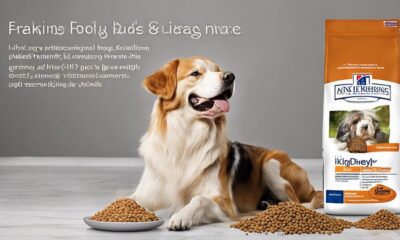
 Vetted3 weeks ago
Vetted3 weeks ago15 Best Dog Foods for Kidney Disease – Expert Recommendations for Your Pet's Health
-

 Vetted2 weeks ago
Vetted2 weeks ago15 Best Affordable Cat Foods That Won't Break the Bank
-

 Deers1 month ago
Deers1 month agoCaring for Baby Deer: Tips for Healthy Fawns
-

 Cats6 days ago
Cats6 days agoCat Weight Chart by Age: Kitten to Senior in Lbs
-
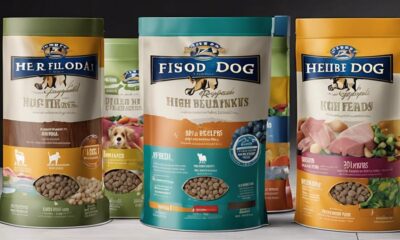
 Vetted1 month ago
Vetted1 month ago15 Best Kibble Dog Foods for a Healthy and Happy Pup




















